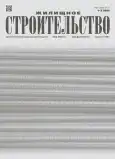The topology of urban development in the Neva delta
- Authors: Demin V.А.1, Pukharenko Y.V.2
-
Affiliations:
- St. Petersburg State Unitary Enterprise of suburban services “Prigorodnoye”
- Saint-Petersburg State University of Architecture and Civil Engineering
- Issue: No 1-2 (2025)
- Pages: 11-19
- Section: Articles
- URL: https://modernonco.orscience.ru/0044-4472/article/view/677178
- DOI: https://doi.org/10.31659/0044-4472-2025-1-2-11-19
- ID: 677178
Cite item
Abstract
The article discusses the influence of the topological features of the Neva River’s adjacent territories on the formation of the planning structure of St. Petersburg. The main topological problem of the city, formulated earlier by V.F. Nazarov, and the solution to this problem in the general plans of St. Petersburg – Leningrad are revealed. The urban planning features of the Admiralty side of St. Petersburg and the formation of the island arrows of the largest cities – St. Petersburg, Paris, New York – are revealed. The conclusion is made about the possibility of using the topological method in the design of new and transformation of existing urban complexes and public spaces.
Keywords
Full Text
About the authors
V. А. Demin
St. Petersburg State Unitary Enterprise of suburban services “Prigorodnoye”
Author for correspondence.
Email: 9426091@gmail.com
Architector
Russian Federation, 197136, Saint-Petersburg, Ordinarnaya Street, 46Yu. V. Pukharenko
Saint-Petersburg State University of Architecture and Civil Engineering
Email: pukharenko.j.v@lan.spbgasu.ru
Doctor of Sciences (Engineering), Professor
Russian Federation, 4, 2nd Krasnoarmeyskaya Street, Saint Petersburg 190005References
- Lavrov L., Molotkova E., Surovenkov A. On evaluating the condition of the Saint Petersburg historic center. Architecture and Engineering. 2020. Vol. 5. No. 3, pp. 29–42. EDN: XTGRAO. https://doi.org/10.23968/2500-0055-2020-5-3-29-42
- Lavrov L.P., Molotkova E.G. Development of the spatial planning framework on the southern bank of the Neva River. Vestnik grazhdanskikh inzhenerov. 2020. No. 5 (82), p. 16. (In Russian). EDN: SRSRNX. https://doi.org/10.23968/1999-5571-2020-17-5-12-19
- Vaitens A.G., Mityagin S.D. Urban and General plans of St. Petersburg – Leningrad – St. Petersburg of the XX – beginning of the XXI centuries: sustainable and changeable. Academia. Arkhitektura i stroitel’stvo. 2024. No. 4, pp. 62–71. (In Russian). EDN: TPLSQN. https://doi.org/10.22337/2077-9038-2024-4-62-71
- Eremeeva A.F., Lavrov L.P. Features of open spaces of the historical center of St. Petersburg in comparison with Venice and Amsterdam. Modern problems. Vestnik grazhdanskikh inzhenerov. 2017. No. 2 (61), pp. 22–33. (In Russian). EDN: YUDESP. https://doi.org/10.23968/1999-5571-2017-14-2-22-33
- Nikolashchenko B.V. Let’s remember Valentin Fedorovich Nazarov. Architecturyi Petersburg. 2017. № 2 (45), pp. 2–3. (In Russian).
- Mazaev G. The riddle of Leblon. Academia. Arkhitektura i stroitel’stvo. 2020. No. 2, pp. 92–99. (In Russian). EDN: PMDWAX. https://doi.org/10.22337/2077-9038-2020-2-92-99
- Zavarikhin S.P., Nefedov V.A., Slavina T.A. Some fundamentals of the theory of architectural and urban planning transformations. Vestnik grazhdanskikh inzhenerov. 2016. No. 6 (59), pp. 49–52. (In Russian). EDN: XGRIVJ
- Mangushev R.A., Novokhodskaya N.S., Datsyuk T.A., Kondratieva L.N. St. Petersburg “Genetic code”. XVIII century and XXI century. Vestnik grazhdanskikh inzhenerov. 2019. No. 5 (76), pp. 33–40. (In Russian). EDN: HBULHU. https://doi.org/10.23968/1999-5571-2019-16-5-33-40
Supplementary files











